Phase One - Setting the Foundation
This phase focuses on laying the foundation for inclusive education by exposing the team to the fundamental core elements of inclusive education. It concentrates on professional development to create change by inspiring a mind shift for an inclusive vision regarding students with the most significant cognitive disabilities and complex access needs.
The Coach Should Assist the Team to:
Identify the members of the inclusive education implementation team and identify their basic roles and responsibilities. Refer to the sample roles and responsibilities from the Coaching and Team Meeting Basics for Inclusive Education course if needed. As a team, define the overall responsibilities of the inclusive education implementation team. These overall responsibilities may be:
- Model and communicate inclusive values and practices.
- Identify areas of improvement needed to obtain a truly inclusive education for all students.
- Develop a plan for change.
- Monitor fidelity by completing fidelity checklists.
- Engage in and provide professional development.
Record the members and the overall responsibilities at the top of the team’s Inclusive Education Implementation Plan.
Establish twice-monthly meeting dates for the inclusive education implementation team for the entire school year. Meetings should have a detailed agenda.

Significant Cognitive Disabilities, Inclusion
Inclusive Education Team Meeting Agenda/Minutes
This blank agenda template can be used to prepare for an inclusive education implementation team meeting.
- Engage in professional development. Each member of the inclusive education implementation team should take the online TX CAN Inclusion Series trainings: Fundamentals of Inclusive Education and Presuming Competence.
- Establish baseline data as a team at a meeting by completing the fidelity checklists for Fundamentals of Inclusive Education and Presuming Competence.
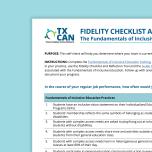
Significant Cognitive Disabilities, Inclusion
Fidelity Checklist and Reflection Tool: The Fundamentals of Inclusive Education
This self-check will help you determine where your team is currently performing in regard to the Fundamentals of Inclusive Education. Complete the Fundamentals of Inclusive Education training and then complete this document to get the baseline for your team. As you move forward in your practice, use
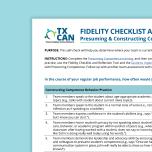
Significant Cognitive Disabilities, Inclusion
Fidelity Checklist and Reflection Tool: Presuming and Constructing Competence
- Use the results of the fidelity checklists and the Guide to Implementation for both Fundamentals of Inclusive Education and Presuming Competence to create initial action items for the Inclusive Education Implementation Plan to increase the team's fidelity.
These items should all be listed as the first “To-Do’s” for the team to complete at the beginning of the Inclusive Education Implementation Plan.
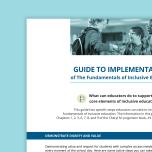
Significant Cognitive Disabilities, Inclusion
Guide to the Implementation of The Fundamentals of Inclusive Education for Students with Complex Access Needs

Significant Cognitive Disabilities, Inclusion
Guide to Implementation of Presuming and Constructing Competence
Example
Here is a sample of one team’s identified roles/responsibilities and initial "To-Do's" from the beginning of their Inclusive Education Implementation Plan. For the full document, see the Sample Phase One Inclusive Education Implementation Plan.
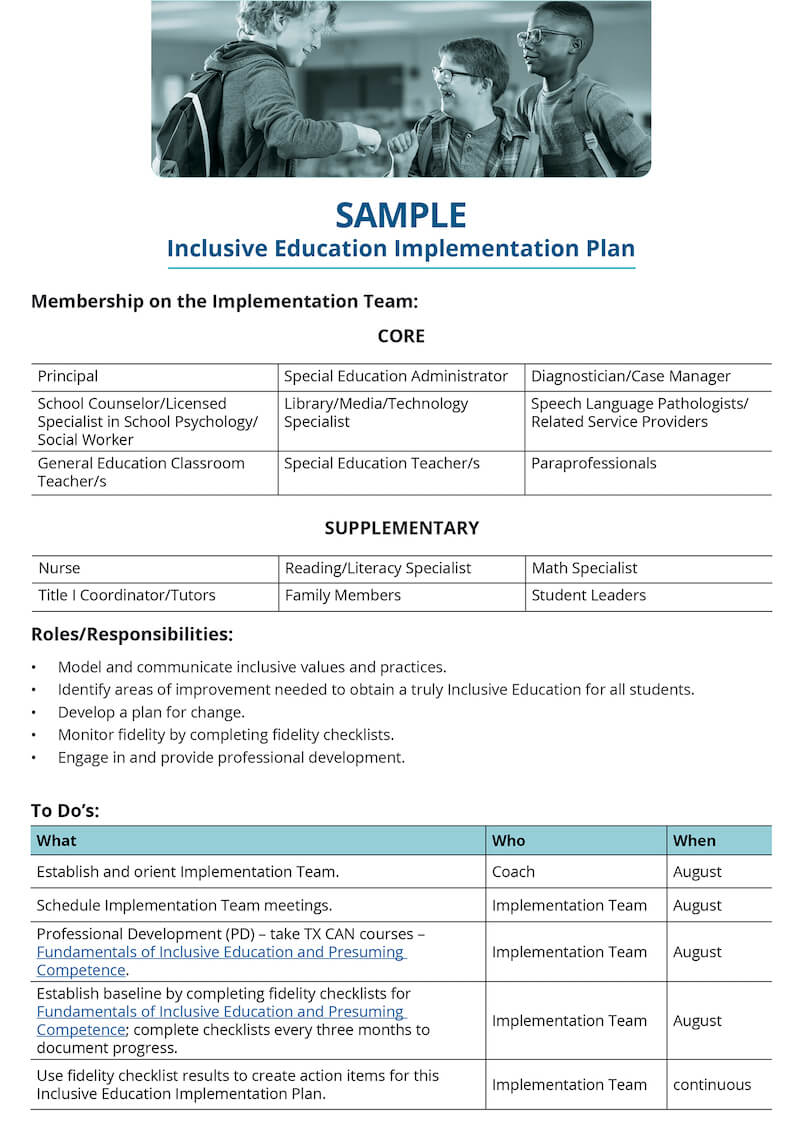
Creating Action Items
Here is where items will begin to vary more significantly from school to school as teams are writing their Inclusive Education Implementation Plans. Each team will have their own unique strengths and weaknesses, varying resources, pre-established practices, and professional development needs. Working together, the team will review the research and guidance, identify the action items, and delegate the “To-Do’s” that will address their unique campus situations moving forward towards inclusive education.
As the coach, keep in mind that Phase One focuses on professional development. Though the team may be eager to start Phase Two (doing the work of “Putting it Into Practice”), high-quality training that supports the core elements of inclusive education will ensure a strong start to implementation. After reviewing the core elements of inclusive education in the Fundamentals of Inclusive Education course, some teams will feel they need extensive professional development. Other teams may be more advanced in their knowledge of the core elements and can quickly jump to Phase Two.
The team may find it helpful to align their Inclusive Education Implementation Plan to the core elements of inclusive education from the Fundamentals of Inclusive Education course as we have done in our Sample Phase One Inclusive Education Implementation Plan. These eight core elements set the foundation for an inclusive education.
- Demonstrate Dignity and Value
- Support an Inclusive Vision
- Presume Competence
- Establish Valued Membership in General Education
- Facilitate Students' Social Relationships
- Provide Supports for Active Participation in General Education
- Develop Collaborative Inclusive Teams
- Encourage Visionary Leadership from School Administrators
Demonstrate Dignity and Value
If aligning their Inclusive Education Implementation Plan to the core elements, the team should begin by creating action items for "Demonstrate Dignity and Value" to start working on a culture change.
Using the “Demonstrate Dignity and Value” section from the Guide to Implementation of The Fundamentals of Inclusive Education, along with the team’s own research and knowledge of their campus, the team comes up with some key action items to improve fidelity for the implementation of this core element and adds these to the Inclusive Education Implementation Plan. The team then creates any specific “To-Do’s” required to make those action items happen and assigns them to a team member with a due date. Remember, Phase One should focus on any needed professional development to lay the foundation for inclusive education.
A TX CAN training you may find helpful for "Demonstrate Dignity and Value" is The Fundamentals of Inclusive Education.
Example
Here is a sample of one team’s initial Phase One planning for this core element. For the full document, see the Sample Phase One Inclusive Education Implementation Plan.
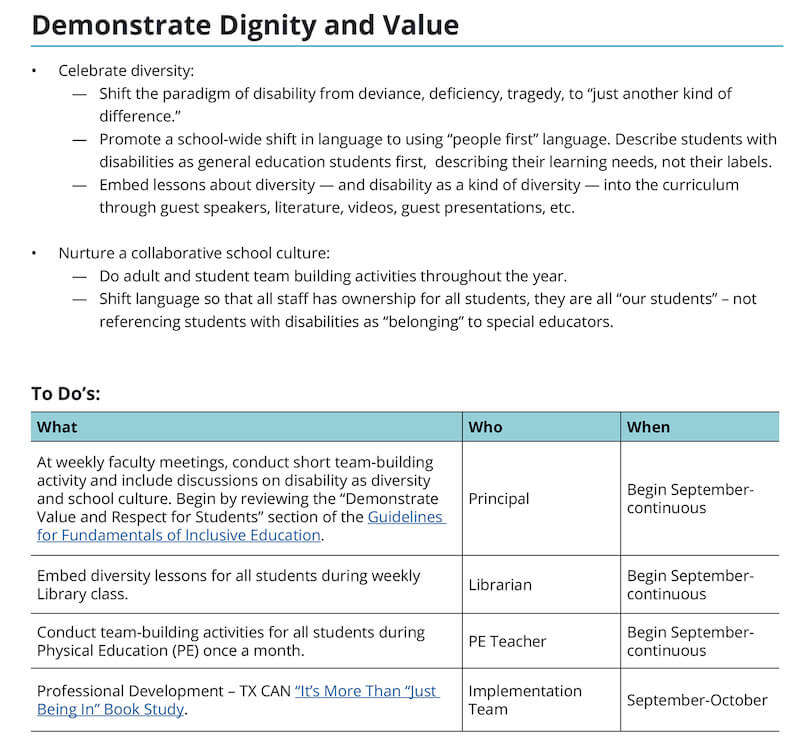
Support an Inclusive Vision
The team should review the next core element, regarding an inclusive vision - a vision of an inclusive education and an ordinary life in the community. This element correlates to The Fundamentals of Inclusive Education Fidelity Checklist and Reflection Tool question #1. Using the “Support an Inclusive Vision” section from the Guide to Implementation of The Fundamentals of Inclusive Education, along with the team’s own research and knowledge of their campus, the team comes up with some key action items to improve fidelity for the implementation of this core element and adds these to the Inclusive Education Implementation Plan. The team then creates any specific “To-Do’s” required to make those action items happen and assigns them to a team member with a due date. Remember, Phase One should focus on any needed professional development to lay the foundation for inclusive education.
A TX CAN training you may find helpful for Inclusive Vision is The Fundamentals of Inclusive Education.
Example
Here is a sample of one team’s initial Phase One planning for this core element. For the full document, see the Sample Phase One Inclusive Education Implementation Plan.
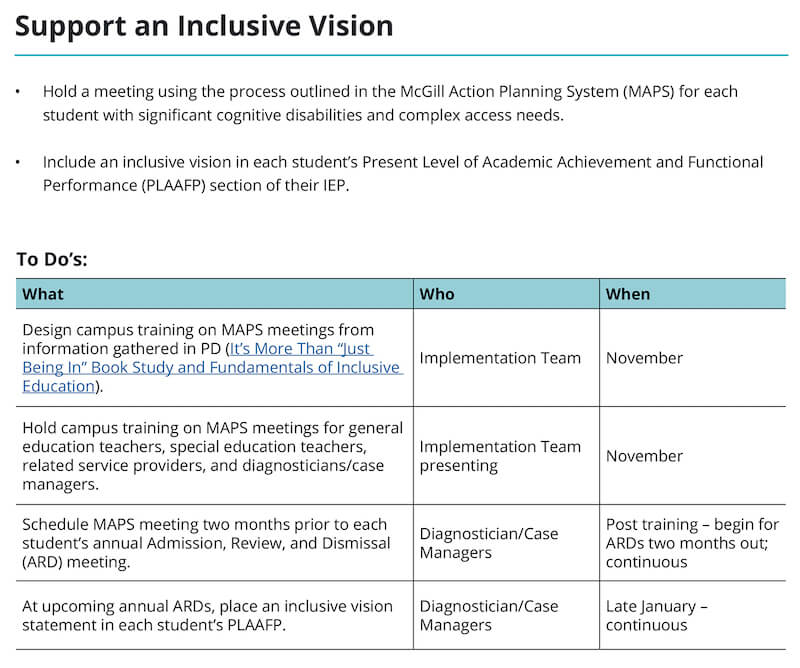
Presume Competence
The team should review the areas on the Presuming Competence Fidelity Checklist and Reflection Tool where the team indicated there is a need for growth. The fidelity check questions correlate to these sections of the Guide to Implementation of Presuming and Constructing Competence:
- Questions #1-3 - How You Speak to Students
- Question #4 - How You Speak about Students
- Question #5 - The Student Profile Section of the IEP, The Evaluation Results and PLAAFP Section of the IEP, and IEP Goals and Benchmarks
- Questions #6-7 - Communication and Assistive Technology Supports
- Question #8 - Placement Decisions
Using the Guide to Implementation of Presuming and Constructing Competence, along with their own research and knowledge of their campus, the team comes up with some key action items to improve fidelity for the implementation of this core element and adds these to the Inclusive Education Implementation Plan. The team then creates any specific “To-Do’s” required to make those action items happen and assigns them to a team member with a due date. Remember, Phase One should focus on any needed professional development to lay the foundation for inclusive education.
Based on the unique needs of the team or individual staff members, you may assign related professional development by selecting from these TX CAN trainings that align to "Presume Competence:"
Example
Here is a sample of one team’s initial Phase One planning for this core element. For the full document, see the Sample Phase One Inclusive Education Implementation Plan.
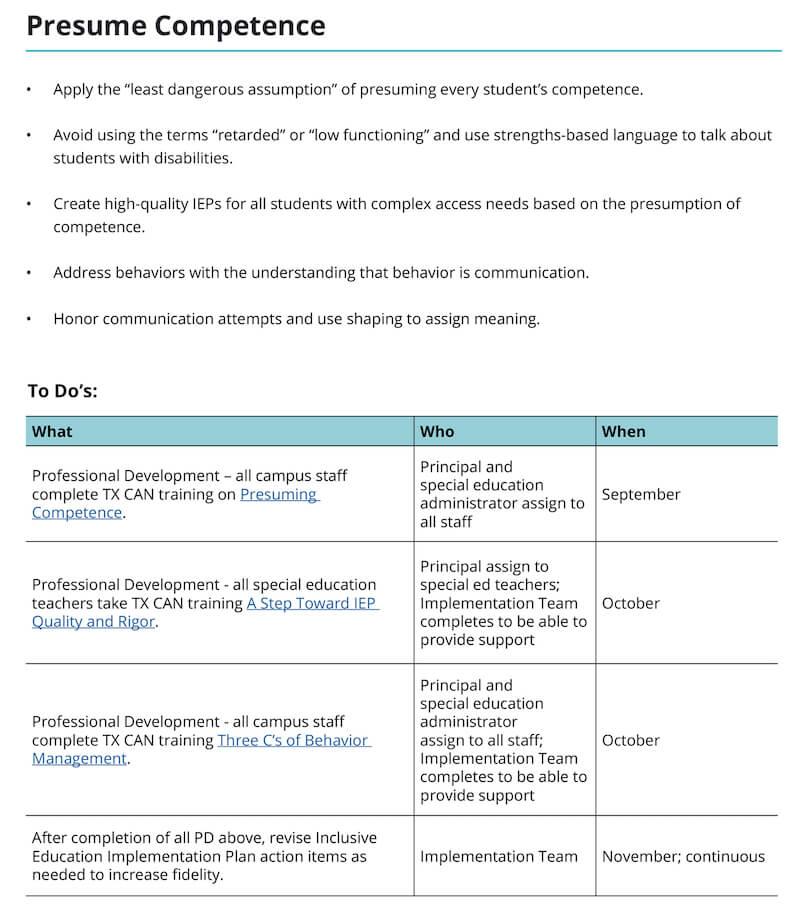
Establish Valued Membership in General Education
The team should review the core element regarding valued membership in general education. This element correlates to The Fundamentals of Inclusive Education Fidelity Checklist and Reflection Tool question #2. Using the “Establish Valued Membership in General Education” section from the Guide to Implementation of The Fundamentals of Inclusive Education, along with the team’s own research and knowledge of their campus, the team comes up with some key action items to improve fidelity for the implementation of this core element and adds these to the Inclusive Education Implementation Plan. The team then creates any specific “To-Do’s” required to make those action items happen and assigns them to a team member with a due date. Remember, Phase One should focus on any needed professional development to lay the foundation for inclusive education.
TX CAN trainings you may find helpful for "Establish Valued Membership in General Education" are:
- The Fundamentals of Inclusive Education
- Transitioning a Student from a Self-Contained to a General Education Classroom
Example
Here is a sample of one team’s initial Phase One planning for this core element. For the full document, see the Sample Phase One Inclusive Education Implementation Plan.
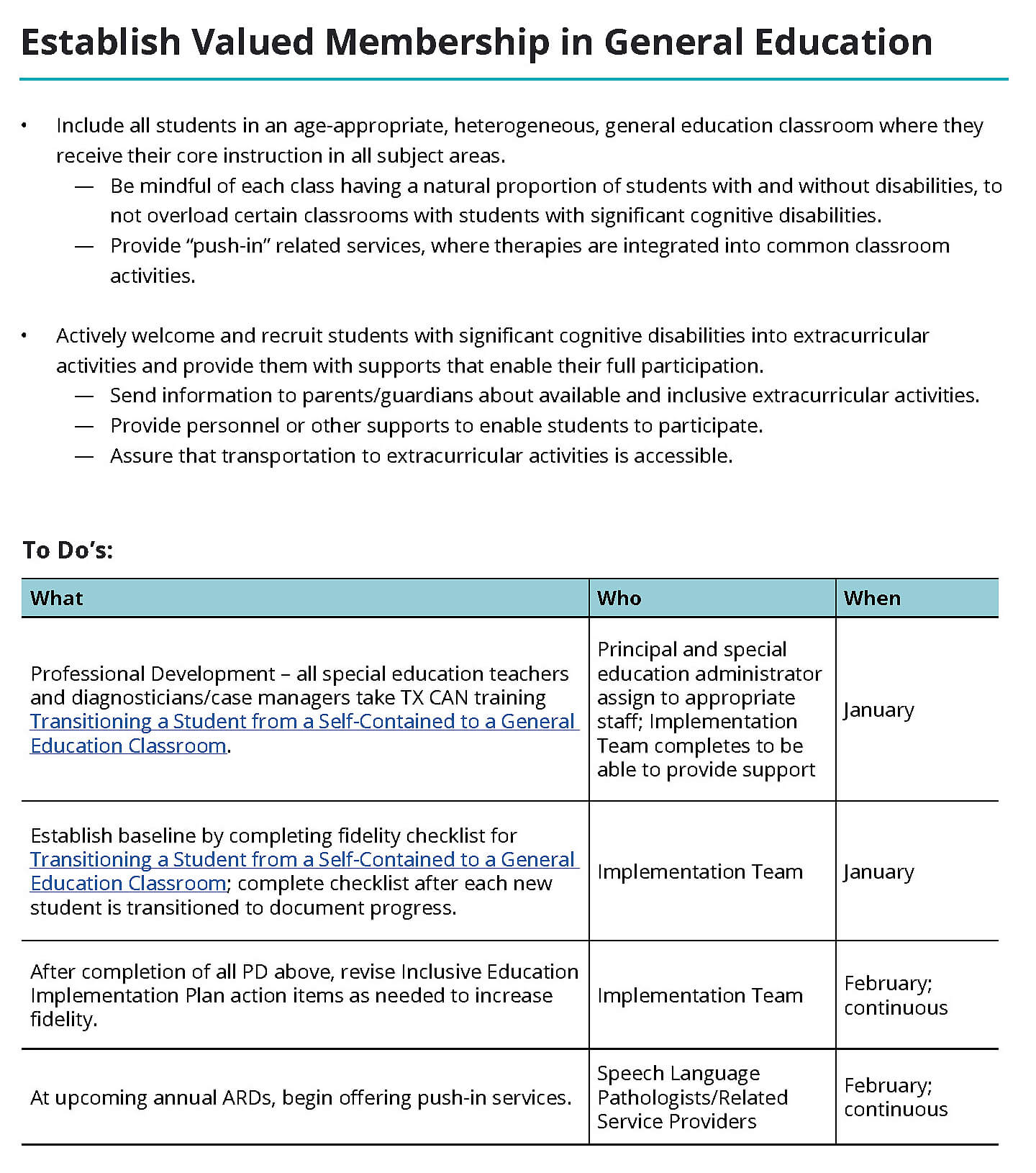
Facilitate Students’ Social Relationships
The team should review the next core element regarding reciprocal social relationships. This element correlates to The Fundamentals of Inclusive Education Fidelity Checklist and Reflection Tool questions #3 and #4. Using the “Facilitate Students’ Social Relationships” section from the Guide to Implementation of The Fundamentals of Inclusive Education, along with the team’s own research and knowledge of their campus, the team comes up with some key action items to improve fidelity for the implementation of this core element and adds these to the Inclusive Education Implementation Plan. The team then creates any specific “To-Do’s” required to make those action items happen and assigns them to a team member with a due date. Remember, Phase One should focus on any needed professional development to lay the foundation for inclusive education.
TX CAN trainings you may find helpful for "Facilitate Students' Social Relationships" are:
- The Fundamentals of Inclusive Education
- Creating and Sustaining Peer Support Networks
Example
Here is a sample of one team’s initial Phase One planning for this core element. For the full document, see the Sample Phase One Inclusive Education Implementation Plan.
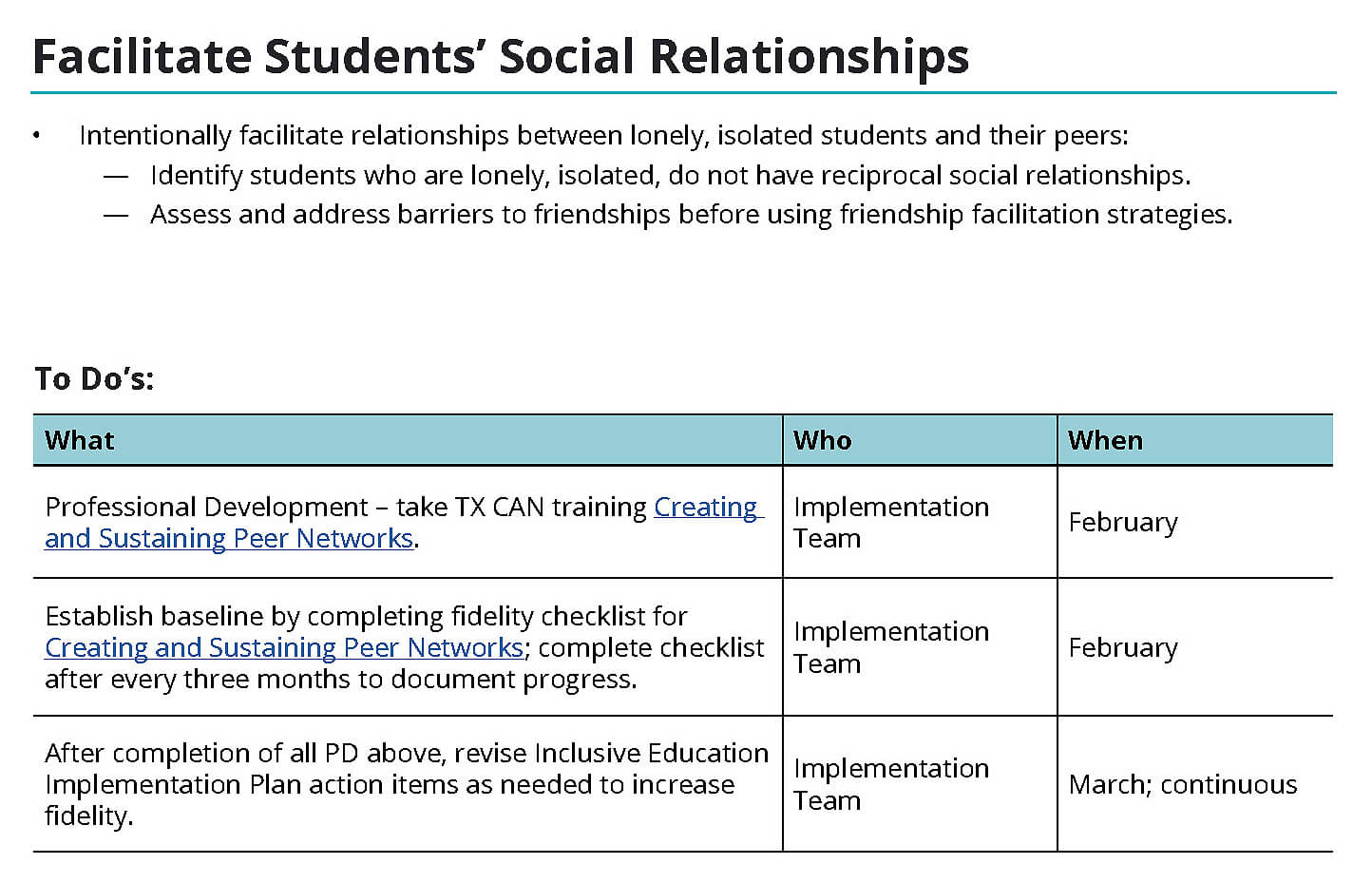
Provide Supports for Active Participation in General Education
The team should review the next core element regarding supports for participation in general education. This element correlates to The Fundamentals of Inclusive Education Fidelity Checklist and Reflection Tool questions #5, #6, and #7. Using the “Provide Supports for Active Participation in General Education” section from the Guide to Implementation of The Fundamentals of Inclusive Education, along with the team’s own research and knowledge of their campus, the team comes up with some key action items to improve fidelity for the implementation of this core element and adds these to the Inclusive Education Implementation Plan. The team then creates any specific “To-Do’s” required to make those action items happen and assigns them to a team member with a due date. Remember, Phase One should focus on any needed professional development to lay the foundation for inclusive education.
Based on the unique needs of the team, or individual staff members, you may assign related professional development by selecting from these TX CAN trainings that align to "Provide Supports for Active Participation in General Education:"
Example
Here is a sample of one team’s initial Phase One planning for this core element. For the full document, see the Sample Phase One Inclusive Education Implementation Plan.
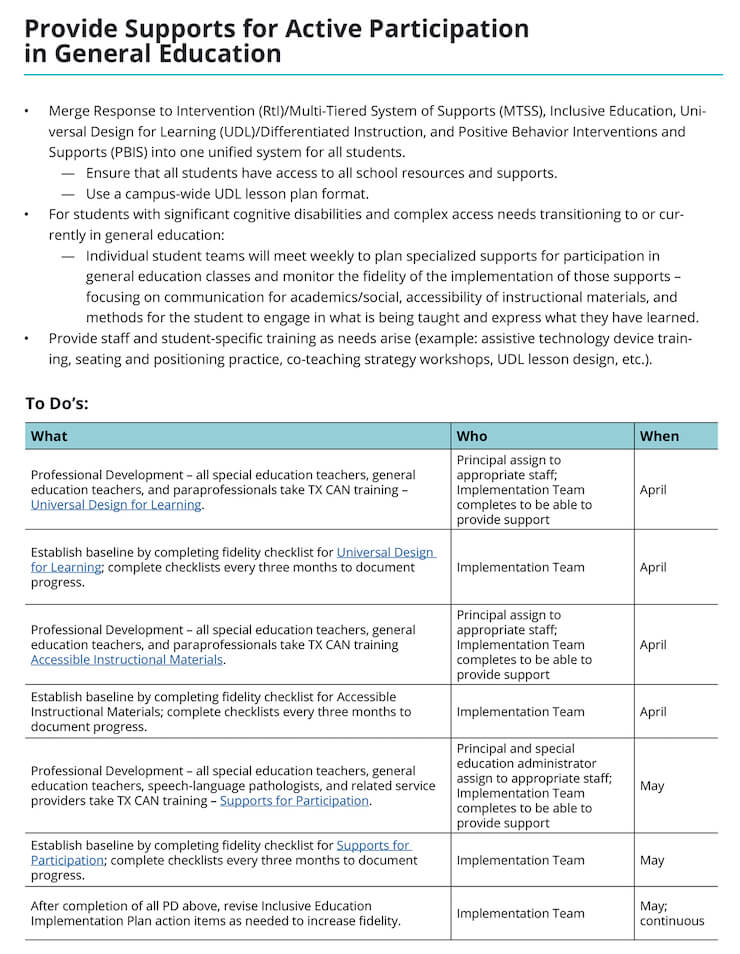
Develop Collaborative Inclusive Teams
The team should review the next core element, regarding collaborative teaming. Using the “Develop Collaborative Inclusive Teams” section from the Guide to Implementation of The Fundamentals of Inclusive Education, along with the team’s own research and knowledge of their campus, the team comes up with some key action items to improve fidelity for the implementation of this core element and adds these to the Inclusive Education Implementation Plan. The team then creates any specific “To-Do’s” required to make those action items happen and assigns them to a team member with a due date. Remember, Phase One should focus on any needed professional development to lay the foundation for inclusive education.
TX CAN trainings you may find helpful for "Develop Collaborative Inclusive Teams" are:
Example
Here is a sample of one team’s initial Phase One planning for this core element. For the full document, see the Sample Phase One Inclusive Education Implementation Plan.
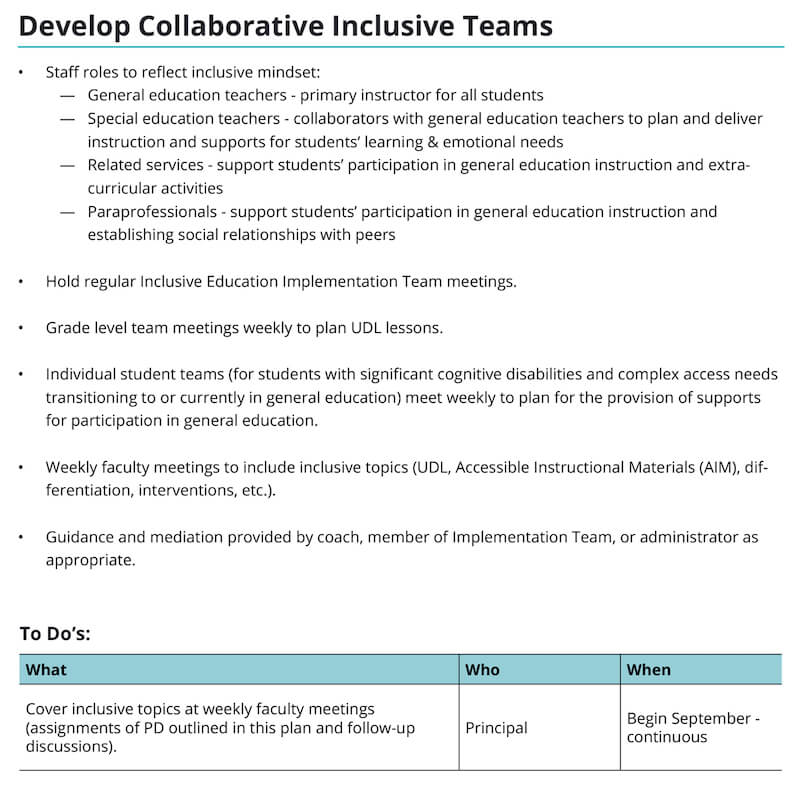
Encourage Visionary Leadership from School Administrators
The team should review the last core element, regarding administrative support. This element correlates to The Fundamentals of Inclusive Education Fidelity Checklist and Reflection Tool questions #8 and #9. Using the “Encourage Visionary Leadership from School Administrators” section from the Guide to Implementation of The Fundamentals of Inclusive Education, along with the team’s own research and knowledge of their campus, the team comes up with some key action items to improve fidelity for the implementation of this core element and adds these to the Inclusive Education Implementation Plan. The team then creates any specific “To-Do’s” required to make those action items happen and assigns them to a team member with a due date. Remember, Phase One should focus on any needed professional development to lay the foundation for inclusive education.
TX CAN trainings you may find helpful for "Encourage Visionary Leadership for School Administrators" are:
Example
Here is a sample of one team’s initial Phase One planning for this core element. For the full document, see the Sample Phase One Inclusive Education Implementation Plan.
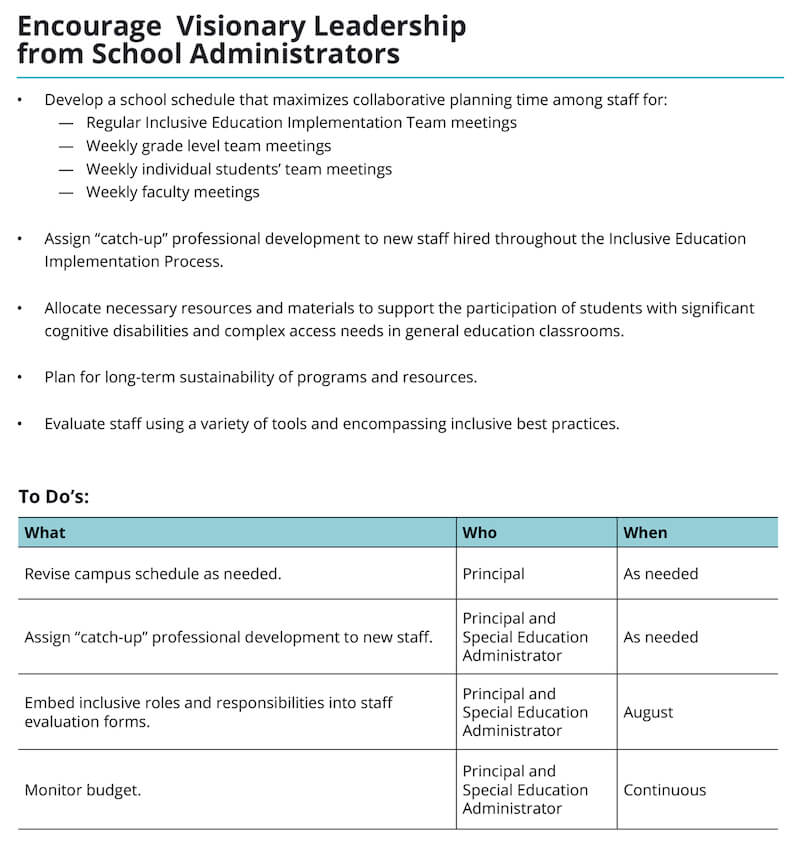
Barriers/Coaching Tips
Until staff fully understand presuming competence and authentic inclusion, coaches might hear staff express many “buts” about inclusive education. Examples include:
- “But she has so many complex needs and is so far behind grade level, what could she possibly get out of being in a general education class?”
- “But he has so many health problems. We can’t possibly address those in a regular classroom!”
- “But I thought that students who take the alternate assessment were precisely those students who should be self-contained?”
- “But other students will ostracize him because of his behavior (drooling, stimming, etc.).”
- “But we don’t have enough staff.”
The coach should acknowledge these concerns and approach them with a spirit of inquiry rather than just strong advocacy. Coaches might say:
“I want to validate your concerns and acknowledge that inclusion is a radically different approach than what many of us have been doing for our entire careers. Change is generally initially uncomfortable, but your school overall shows openness to learning some new ways of doing things. As we move forward, working together, we will be exploring these questions and many more. Students will not be moved from their current classrooms into general education classrooms until the student and the teacher are prepared. I am committed to working with you to answer your concerns and to assure that the process of adopting inclusion is done well with enough support for families, staff, and students.”
- Focus staff efforts on building their capacity for implementing best practices. During Phase One, the focus should be on professional learning to establish a foundation for inclusive education.
- Work with the inclusive education implementation team to create common planning time with focused agendas and hold efficient, effective meetings. If needed, guide the team through more formal professional development designed to improve team functioning, including their effective and efficient use of common planning time – using the meeting structures, processes, and skills from the Coaching and Team Meeting Basics for Inclusive Education.
